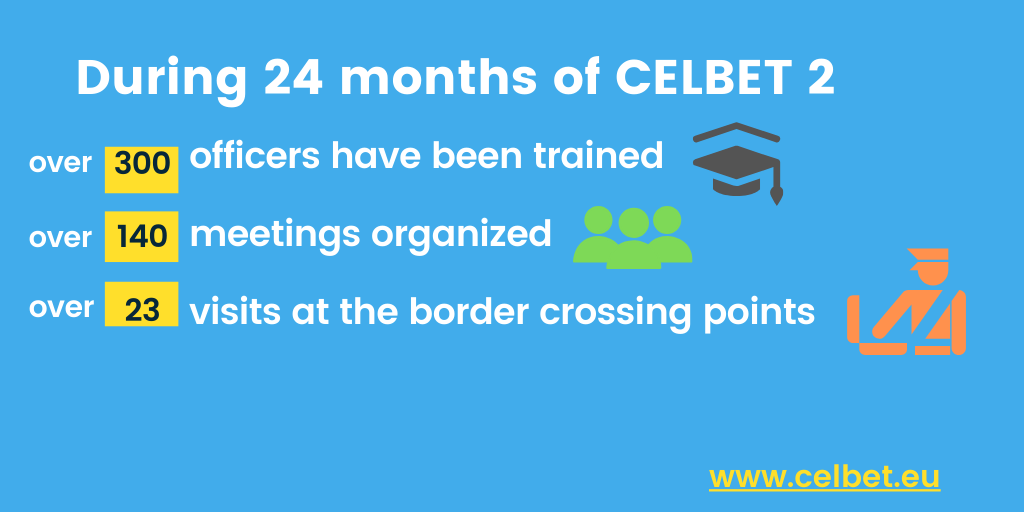April 15th was the last day of CELBET 2, which started in April 2018. Within the 24 months over 130 meetings, 23 site visits, 14 trainings have been organized, 300 officers have been trained, over 9200 data were processed to make the inventory of equipment, over 1500 seizures were collected and analysed. On 76 border crossing points: 62 road BCPs and 14 rail BCPs Operational Controls Team organized Joint Intensified Activities.
Teams reports, analyses and activities that gave a broader picture of threats, gaps related to resources, control equipment, working methods and management of risks of 174 border crossing points at the EU Eastern and South-Eastern land border.
About 300 people: team leaders, experts, networks members, contact points from CELBET Member States have been involved in different activities of the project.

► During CELBET 2 many different networks have been created: BCP network, NCP Network, Training Network, Procurement Expert network, NRAC Network and PR Network. The networks enable experts and officers to enhance cooperation, to spread CELBET recommendations, receive feedback to the teams and work out practical solutions. Meetings within the networks help to make contact, to know each other better and the same time to share information and experience.
►The biggest network is BCP Network, which is consisted from 3 regional groups: North, Central and South Network. Thanks to that CELBET experts connected with the officers from the first line of control and what is the most important nowadays – experts reached the data and information from the source. In the second edtion of CELBET six regional meetings have been organized and one plenary.
►300 is the number of trained officers. This was possible thanks to training system and Centres of Expertise created by Training team: Car search, X-ray image analyzing, Sniffer dogs training and E-learning. What is Center of Expertise ? A physical or virtual place where the expertise of EU experts are collected, based on the Training Questionnaire/existed experiences/previous CLEP. All Centres:
- providing international trainings;
- managing the experts’ network;
- giving advice;
- developing and sharing training materials;
- providing experts;
- organising regular meetings for the trainers/experts.
►Precious information on strong and weak areas of the border crossing point is now possible thanks to the BCP Diagnostic study. It’s a kind of a mission, when the Diagnostic team will evaluate performance and capacity of the BCP. The study should give an answer on the strengths and weaknesses of the BCP, what can be changed in short and long term, what are the possibilities, and how can the changes be done. The Diagnostic Study Tool supports the diagnostic study team to perform the evaluation. The tool is a unique Excel table with key-factors which cover all areas of the BCP: infrastructure, equipment, customs controls, risk management, training, cooperation and management.
►If You know the risk you know how to prepare. The Risk Management Team created “List of Risks”. It is an excel template which was used to identify what kinds of risks and threats might be present at the borders. The List gives a possibility to evaluate and compare risks at neighbouring BCPs, Member States and border strips in road and rail traffic.
►One of the product of Equipmet team is X-ray image and data exchange platform. It has been created to ensure exchange of X-ray images between CELBET MS with the purpose of enhancing training of x-ray operators and to develop their skills and ability to analyse X-ray images. X-ray image and data exchange platform is available on CELBET Training Platform – www.edu.celbet.eu
►Idea of joint management procedure during the emergencies and peak times at the border crossing point was worked out by Cooperation Team. Experts have made it by exploring existing agreements on throughput capacity of border crossing points in Estonia, Finland, Hungary, Latvia, Lithuania, Poland and practical situations facing in real life, worked out the definition of emergencies and peak time at the border crossing points. The idea of joint management procedure of the emergencies and peak times at the BCP was presented and promoted to border control authorities from Belarus, Greece, Lithuania and North Macedonia. Greece tested the standard national procedure on 20-27 January 2020 at the border crossing point Evzonoi. In turn Lithuania and Belarus adopted the advanced module of international agreement and on 4 November 2019 signed the protocol to ensure the uninterrupted flow of vehicles and to increase the throughput capacity of road border control points at the Lithuanian-Belarusian border.
►Using the data of year 2018, collected from the Member States by Land Frontier Contact Group, the Operational Controls team expert compiled a “Vulnerability Study” containing the “vulnerability indexes” values of the BCP at the EU Eastern and South- Eastern land border. The objective of “vulnerability index” is to provide support for a cost- effective mitigation of the smuggling pressure. This innovative tool is dedicated to the strategic management of the national customs administrations to use and decide priorities with regard to the following: recruitment of customs officers, purchase of customs control equipment, development of infrastructure in the BCP, design by case contingency plans1 and planning customs controls.

![]()

